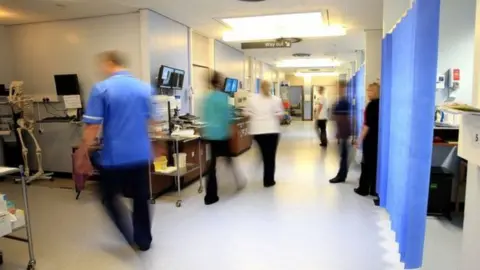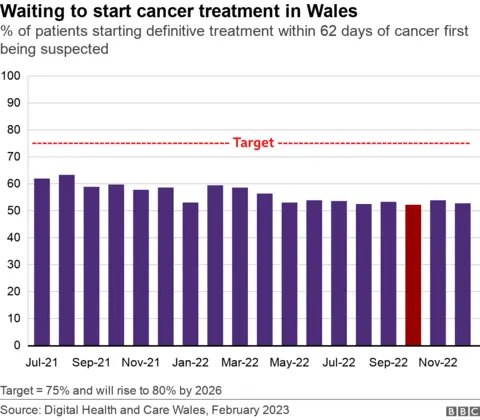NHS Wales waiting times: 75,000 outpatient waits of year
 PA
PAThe first target to tackle the NHS backlog after the Covid pandemic has been missed.
Almost 75,000 people are waiting a year or more for an outpatient appointment when there should be none.
The Welsh government said it was "disappointed that this ambitious target... has not been met".
However, ambulance response times, handover delays and A&E waiting times have improved from record lows seen in the previous month.
The number of people waiting for hospital treatment has also fallen for the third successive month.
'You're just sat there in limbo wondering what's going on'

Anna Prince, from Barry, Vale of Glamorgan had been feeling unwell for several years with bouts of "utter exhaustion" but the crunch point came when she lost the sight in one eye and felt extreme pain.
After various ailments were ruled out she was referred for an MRI scan.
"They put me down as an emergency," she said. "I had to wait 12 weeks, which is quite long for an emergency, especially when you're in agonising pain. Unfortunately it got pushed back two or three times and it ended up being a few months.
"They've more or less said I have multiple sclerosis (MS) however they need to do certain steps in that journey to get me to the official diagnosis.
"The care I've had has really been exemplary and they've really looked after me," but Ms Prince said the stumbling point has always been the wait to see specialist consultants.
"It's the not knowing," she said. "When they tell you 'we think you have MS but we need to do all these steps first' you're just sat there in limbo wondering what's going on. And in the meantime I'm still having issues with my balance and coordination and dizziness.
"Because I haven't been as active I feel it's impacted my mental health as well as my physical health."
Ms Prince, 44, is a physical trainer and used to own her own gym, but her health and cost of living made that impractical, so she closed the business and works at a friend's gym, also in Barry.
"I couldn't commit as much as I wanted for my members, there were times I couldn't even get out of my bed."

The post-Covid target, set by the Welsh government in April last year, was to see no-one waiting more than a year for a first appointment by the end of 2022, but that figure stood at 74,976.
Nearly 42,000 people waiting a year on more were in three specialisms: Ophthalmology, ear nose and throat, and trauma and orthopaedics.
The Welsh government said it would continue to press health boards to focus on the longest waiters, once urgent cases had been dealt with.
Conservative health spokesman Russell George said to miss the target "by tens of thousands is an undeniable failure".
Plaid Cymru health spokesman Rhun ap Iorwerth called for innovative thinking, saying the Welsh government was "utterly failing" to manage the health service, even against its own revised targets and despite "repeated assertions from the health minister that the targets were achievable".
There was an improvement in ambulance response times, with 48.9% of immediately life-threatening "red" calls arriving within eight minutes in January, but still worse than 12 months earlier and below the 65% target.
There were 23,035 "lost" hours by ambulances spending time outside major A&E units, unable to drop off patients beyond the 15 minute target - the lowest figure for six months.
There was also a fall in the number of patients stuck in hospital despite being well enough to be discharged, down about 10% compared to the previous month, but there were still about 1,000 patients waiting for a care package or support to be arranged.
These latest figures cover the period of industrial action by nurses in December 2022 and ambulance staff in January of this year.
It provides an important context when we see that daily 999 calls during January fell by nearly a quarter.
Attendances at A&E also fell on the previous month.
Waiting lists for hospital treatment fell by 1.75% to a total of 735,139 patient pathways but this is still the sixth-highest number on record.
With some patients on more than one waiting list, it is estimated there were 577,400 individuals waiting - down 8,500 on the month.
Numbers waiting a year or more - just under 162,000 - fell for a fourth month in a row while those waiting two years or more - 6.2% of the waiting list - also dropped.
There are still 22% of those on the waiting list waiting more than a year in Wales, compared to less than 6% in England, where almost no-one is waiting more than two years.
The Royal College of Surgeons said the fall in waiting times was good news for patients and surgeons but "small drops on a huge backlog".
Its director in Wales, Prof Jon Barry, said: "It is testament to the incredible efforts colleagues across the health service in Wales have been putting in, in incredibly difficult circumstances.
"We are yet to see the full impact of winter pressures and industrial action on waiting times but I am hopeful that the high we reached in November is now in terminal decline."
Health Minister Eluned Morgan told BBC Wales: "I'm having very intensive meetings with health boards - last week I had an orthopaedic summit meeting, asking why our performance was not meeting that of England and how do we drive productivity to meet that of England."
A&E waiting times also showed an improvement on a record low in the previous month, with 69.9% of people were seen within the four-hour target in January.
Meanwhile, 8,999 people spent 12 hours or more in A&E before being seen - no-one should wait that long under current targets - although this was the lowest in more than a year.
The median waiting time of two hours and 35 minutes was the shortest since April 2021.

However, cancer performance figures have deteriorated.
Fewer people started their first treatment in December than the previous month and the number given the all-clear also fell.
Performance against the 62-day targets also fell to the second lowest on record - 52.9%.
Katie Till, of Cancer Research UK in Wales said: "It's unacceptable that only half of cancer patients in Wales are being treated quickly enough."
The Welsh government said: "December was one of the toughest months in the history of the NHS, with high Covid and flu rates, huge demand caused by concerns over Strep A and industrial action impacting on activity.
"Despite the pressures, progress continues to be made across planned and emergency care in the NHS in Wales."


This set of figures comes with some health warnings of its own.
December was the busiest the NHS in Wales has experienced, which undoubtedly saw demand increase.
But the impact of industrial action looms large here.
During three days of strikes by ambulance workers the public was warned only the most urgent calls would get a crew - perhaps no wonder then that ambulance response times or waits at A&E were better, when resources were only sent to "red" calls.
Unpicking the impact of the nurses' strikes in December is a little harder. Waiting lists for treatment are continuing to fall but worryingly cancer performance figures have all deteriorated.
When some specialisms can only treat a quarter of patients within the 62 day target, the experience - and outcome - for patients is naturally affected.

Enter a postcode to find out what is happening in your area with A&E, ambulances and hospital waiting lists across the UK.
